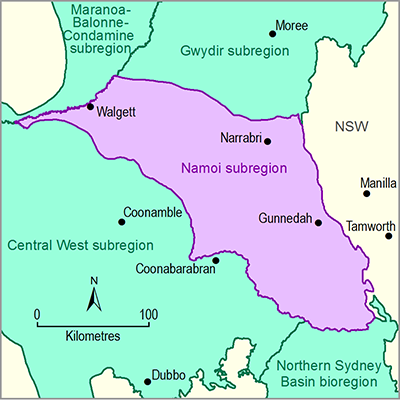About the subregion
This synthesis presents key findings from the bioregional assessment of the Namoi subregion, part of the Northern Inland Catchments bioregion.
Located in the Murray–Darling Basin in central NSW, the subregion lies in the Namoi river basin, which includes the Namoi, Peel and Manilla rivers. Its largest towns are Gunnedah, Narrabri and Walgett.
The subregion covers 29,300 km2; however, the total area investigated, the assessment extent, is 35,660 km2 (Figure 2).
This assessment considered two futures: the baseline and the coal resource development pathway (Box 1). The baseline future comprises six existing coal mines: five open-cut and one longwall. The ten additional coal resource developments comprise three expansions to coal mines, six new coal mines and one coal seam gas (CSG) development. Eight of these additional coal resource developments had sufficient information for hydrological modelling.
Potential hydrological changes
Regional-scale hydrological modelling identified potential changes in groundwater and streamflow due to these eight additional coal resource developments. To rule out impacts on water-dependent ecosystems and assets, a zone of potential hydrological change (Figure 1) identified areas where hydrological modelling predicted changes. The zone comprises 20% of the assessment extent, covers 7014 km2,and includes 5521 km of streams.
Within the zone, 2299 km2 have at least a 5% chance of more than 0.2 m of drawdown due to additional coal resource development (Figure 9). Of this, 287 km2 are in the alluvium, representing around 8% of the upper Namoi alluvium and 0.01% of the lower Namoi alluvium.
Modelling identified 1678 km of streams with at least a 5% chance of an increase of more than 3 zero-flow days per year. Reductions in number of high-flow days, and reductions in total streamflow, occur for much shorter lengths of streams.
Within the zone, 66% of the total 5521 km of streams are potentially impacted but unquantified because of mine proximity or due to extrapolation difficulties. The assessment cannot rule out potential changes in these streams.
Potential impacts
Water-related ecological changes are most likely in floodplains or lowland riverine ecosystems. Potential ecosystem impacts are mostly limited to short sections of streams and their associated floodplains immediately downstream of additional coal resource developments. Two of the 22 springs in the assessment extent potentially experience hydrological changes due to additional coal resource development.
Of the 1690 ecological assets in the assessment extent, 624 are in the zone of potential hydrological change. Of these, 161 are found in areas that are relatively ‘more at risk of hydrological changes’ (Box 10), and the risk for 10 assets remains unquantified.
Impacts on surface water availability in rivers are likely to be minor. Of the 8953 bores in the assessment extent, 8424 are very unlikely (less than 5% chance) to be impacted due to additional coal resource development. Outside the mine pit exclusion zone (Box 3), there are 118 bores with a greater than 5% chance of more than 2 m additional drawdown.
The greatest confidence in hydrological modelling results is in those areas where impacts are very unlikely. Where potential impacts are identified, further local-scale modelling may help with clarifying impacts to ecosystems.
Box 1 Investigating two potential futures
Results are reported for two potential futures:
- baseline coal resource development (baseline): a future that includes all coal mines that were commercially producing as of December 2012
- coal resource development pathway (CRDP): a future that includes all coal mines and coal seam gas fields that are in the baseline as well as the additional coal resource development, those coal mines and coal seam gas fields expected to begin commercial production after December 2012, including expansions of baseline operations.
The difference in results between CRDP and baseline is the change that is primarily reported in a bioregional assessment. This change is due to additional coal resource development.
The CRDP for the Namoi subregion was based on information available as of December 2015. However, coal resource developments may change over time or be withdrawn, or timing of developments may change. Factors such as climate change or land use were held constant between the two futures. Although actual climate or land use may differ, the effect on results is expected to be minimal as the assessment focused on the difference in the results between the CRDP and baseline, minimising the impacts of changes that occur in both futures.

Product Finalisation date
- Executive summary
- Explore this assessment
- About the subregion
- How could coal resource development result in hydrological changes?
- What are the potential hydrological changes?
- What are the potential impacts of additional coal resource development on ecosystems?
- What are the potential impacts of additional coal resource development on water-dependent assets?
- How to use this assessment
- Building on this assessment
- References and further reading
- Datasets
- Contributors to the Technical Programme
- Acknowledgements
- Citation
